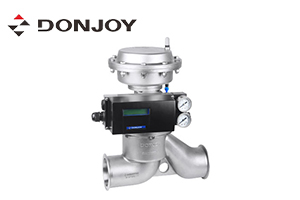1. Installation of flanged ball valve
Preparation before ball valve installation
1) The front and rear pipes should be coaxial, and the sealing surfaces of the two flanges should be parallel. The pipeline should be able to bear the weight of the ball valve, otherwise there must be proper supports on the pipeline.
2) Purge the pipelines before and after the valve to remove oil, welding slag and all other impurities in the pipeline.
3) Check the mark of the ball valve to find out that the ball valve is intact. Open and close the valve several times to verify that it is working properly.
4) Remove the protective pieces on the connecting flanges at both ends of the ball valve.
5) Check the valve hole to remove possible dirt, and then clean the valve hole. Even small particles of foreign matter between the seat and the ball can damage the seat sealing surface.
Steps in ball valve installation
1) Install the ball valve on the pipeline, any end of the ball valve can be installed on the upstream end. The handle-actuated ball valve can be installed anywhere on the pipeline. However, the ball valve with gearbox or pneumatic should be installed upright, that is, installed on the horizontal pipeline, and the driving device should be above the pipeline.
2) Install a gasket between the valve flange and the pipeline flange according to the pipeline design requirements.
3) The bolts on the flange should be tightened symmetrically, sequentially and evenly.
Inspection of ball valve after installation
1) Operate the driver to open and close the ball valve several times, and it should be flexible and not stagnant, confirming that it works normally.
2) Check the sealing performance of the flange joint surface between the pipeline and the ball valve according to the pipeline design requirements.

2. The use of ball valves
1) The disassembly and decomposition operation can only be carried out after it is confirmed that the upstream and downstream pipelines of the ball valve have been depressurized.
2) Non-metal parts should be removed from the cleaning agent immediately after cleaning, and should not be soaked for a long time.
3) The bolts on the flange must be tightened symmetrically, gradually and evenly during assembly.
4) The cleaning agent should be compatible with the rubber parts, plastic parts, metal parts and working medium (such as gas) in the ball valve. When the working medium is gas, gasoline (GB484-89) can be used to clean metal parts. Clean non-metallic parts with pure water or alcohol.
5) Each single ball valve part that is decomposed can be cleaned by dipping. The metal parts with the non-metal parts remaining undecomposed can be scrubbed with a clean and fine silk cloth impregnated with cleaning agent (to prevent the fibers from falling off and adhering to the parts). When cleaning, all grease, dirt, glue, dust, etc. adhering to the wall must be removed.
6) When disassembling and reassembling the ball valve, care must be taken to prevent damage to the sealing surface of the parts, especially non-metallic parts. Special tools should be used when removing the O-ring.
7) After cleaning, it needs to be assembled after the cleaning agent on the wall to be washed has volatilized (it can be wiped with a silk cloth that has not been soaked in the cleaning agent), but it should not be put on hold for a long time, otherwise it will rust and be polluted by dust.
8) New parts also need to be cleaned before assembly.
9) Lubricate with grease. Grease should be compatible with ball valve metal materials, rubber parts, plastic parts and working medium. When the working medium is gas, for example, special 221 grease can be used. Apply a thin layer of grease on the surface of the seal installation groove, apply a thin layer of grease on the rubber seal, and apply a thin layer of grease on the sealing surface and friction surface of the valve stem.
10) Metal chips, fibers, grease (except those specified for use), dust and other impurities, foreign objects should not be allowed to contaminate, adhere or stay on the surface of the parts or enter the inner cavity during assembly.



